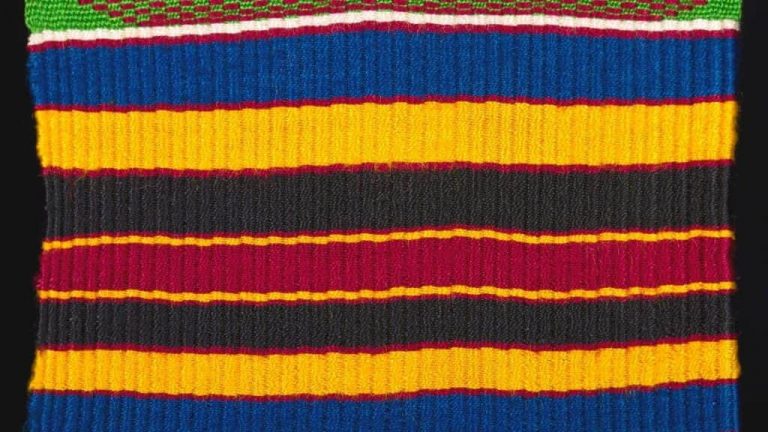Ghanaian Kente fabric is one of the most elegant coloured fabrics that is used in the clothing industry, made by Asante and Ewe weavers using specially designed looms. Kente cloth was likely introduced in western Sudan throughout the 16th century when heavy, non-toxic variations of the fabric were created for wealthy tribal chiefs and easier designs became accessible for the general citizens.
Kente is woven in four-inch (9.5 cm) thin strips which are stitched together. A feature Asante kente has geometric shapes stitched in bright colours across the whole length of the clothing, whilst Ewe kente frequently displays a tweed impact by plying together different coloured threads in a lot of the warps.
Ewe kente cloth typically incorporates graphic symbols.

Hold a part of kente fabric between your palms, and the very first thing you see is probably the bright, vibrant colours of yellow, blue, red, and green. You may notice several rows of layouts, that can be indistinguishable on the front and rear of the fabric. If you understand what to search for, you might even be able to”read” it, gleaning a proverb or governmental statement from its own threads.
Kente cloth comes out of a cloth practice that originated in Ghana in centuries past. The cloth has come to signify ethnic affiliations from West Africa throughout the diaspora, but legend has it that a spider spinning an intricate web inspired the oldest kente methods and layouts.
Weaving Kente fabric is a cultural heritage of their Asante (also called Ashanti) individuals, and such clothes were initially used exclusively to groom their courts. It means “if you climb a fantastic tree you’re provided a push;” put another way, when a person takes up a worthy cause, an individual will be encouraged by their own community.
The Ewe people of western Africa have also woven kente fabric for centuries, although though based on kente master weaver Kwasi Asare, who’s often commissioned to make unique kente designs and teaches workshops in the U.S, their layouts are usually more “symbolic”, and in which Asante kente designs have a tendency to be more subjective.
Several kente patterns are invented, every one of which includes a particular idea or concepts traditionally associated with the symbols above. By way of instance, the Obaakofoo Mmu Man design represents democratic principle; Emaa Da, novel creativity and knowledge of experience; and Sika Fre Mogya, the duty to discuss financial success with the relations.
Nowadays, the fabric can be bought and worn out by local folks and kente outfits are now extremely popular to wear at weddings and special events.
Akans, From the Ashanti kingdom, traditionally wear clothing made from kente fabric. It’s a source of pride for all Ghanaians as well as the Diaspora.
First kente cloth is a standing symbol of wealth and individuality since it’s a luxurious and costly fabric.
But, Ankara cloth producers in Ghana and China, as an instance, are replicating the kente layouts.
African wax print cloth is more economical and less expensive than the original kente cloth fabric as they’re produced by machine. This is very likely to have led to the global prevalence of ‘kente print’ since it’s more readily accessible.
It’s also urged young, aspiring fashion designers to experiment with printed cloth by making contemporary African printed clothes. Also as Ghanaian clothes style, kente prints can now be utilized in homeware like blankets, pillowcases, and placemats.
Raw Materials & Preparation
The type of raw materials used for weaving include:
The dye used to alter the thread colour could be made locally by squeezing the leaves or bark of trees. Local dyes are favoured as the colours don’t fade but many dyes have been taken out of China or Japan.
Kente, based in the 17th century by people in the realm of Asante; By 3000 BC, it could be credited to the long tradition of African American fabrics. Due to Kente’s standing in the world, we finally have a varied group of individuals both inside and beyond the continent that also weave layouts.
Elegant Kente cloths are constantly in demand in Ghana and globally. The cloth itself is a part of the Ghanian tradition.
This cloth is used by virtually all in the tribes of Ghana.
Kente Cloth is the most well-known and renowned of all of the fabrics used in Ghana.